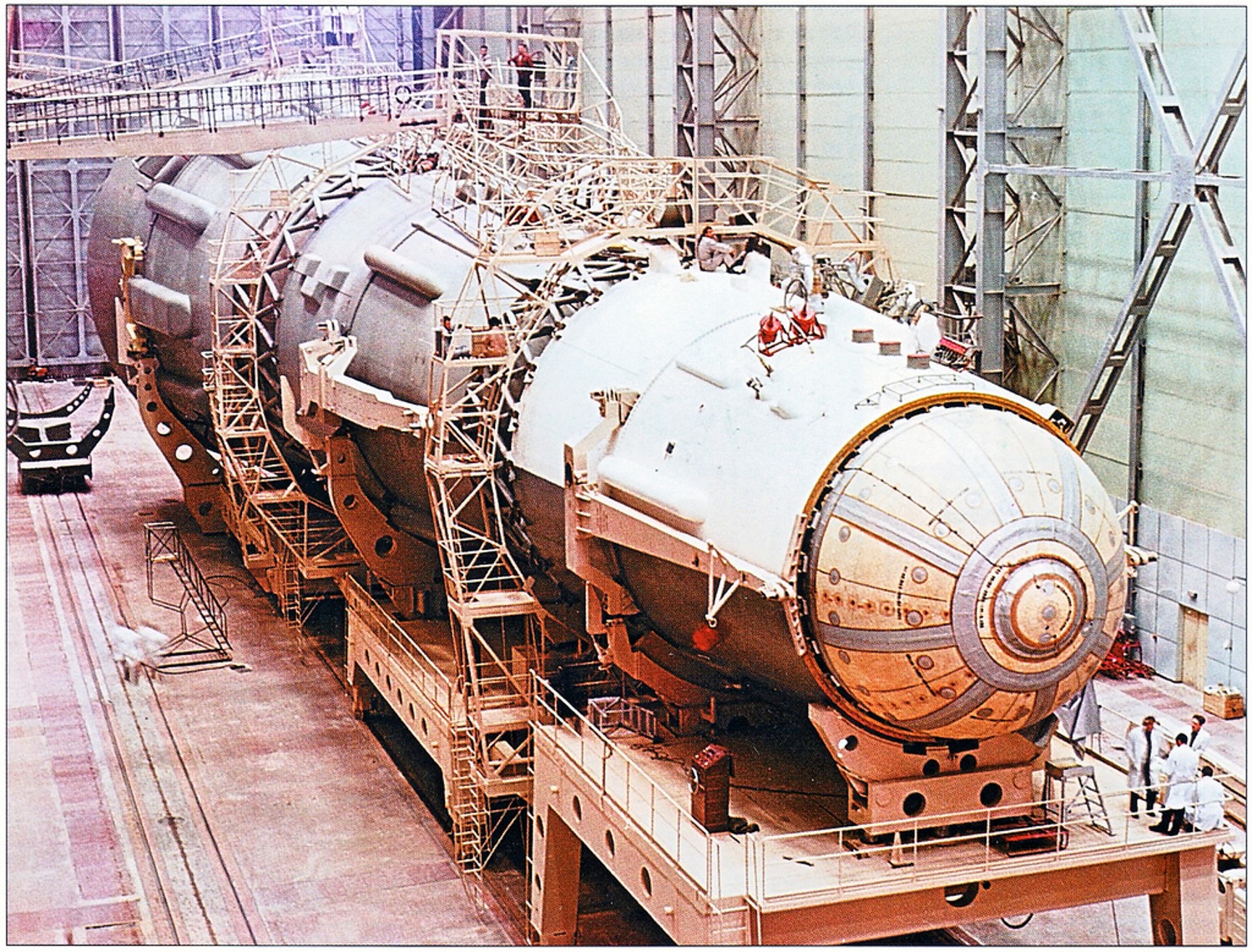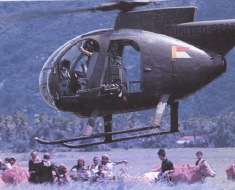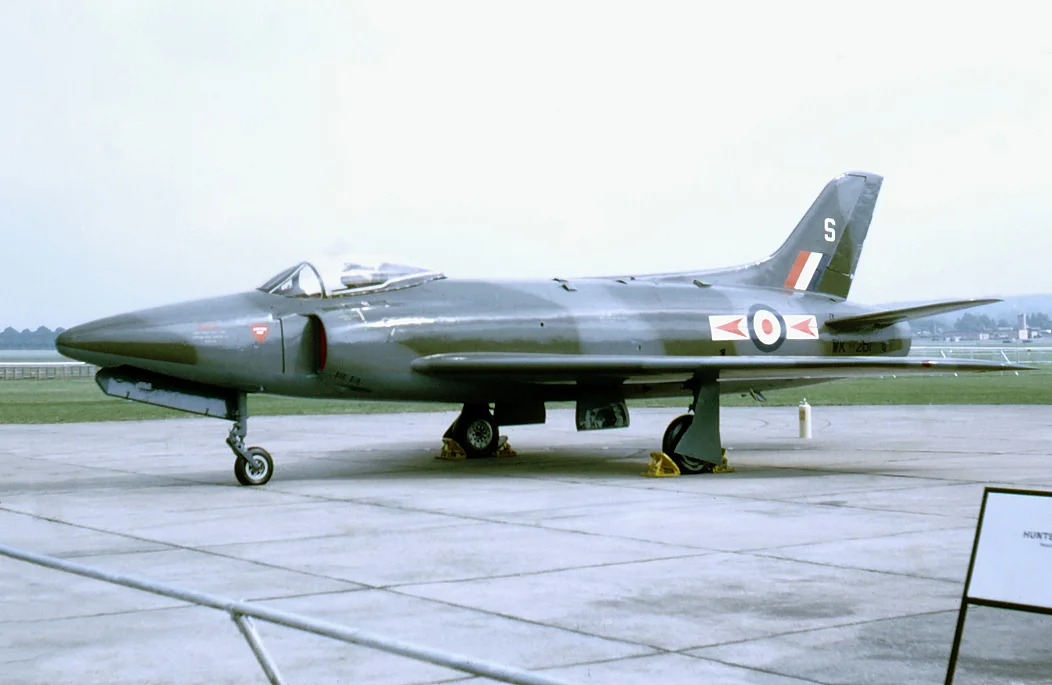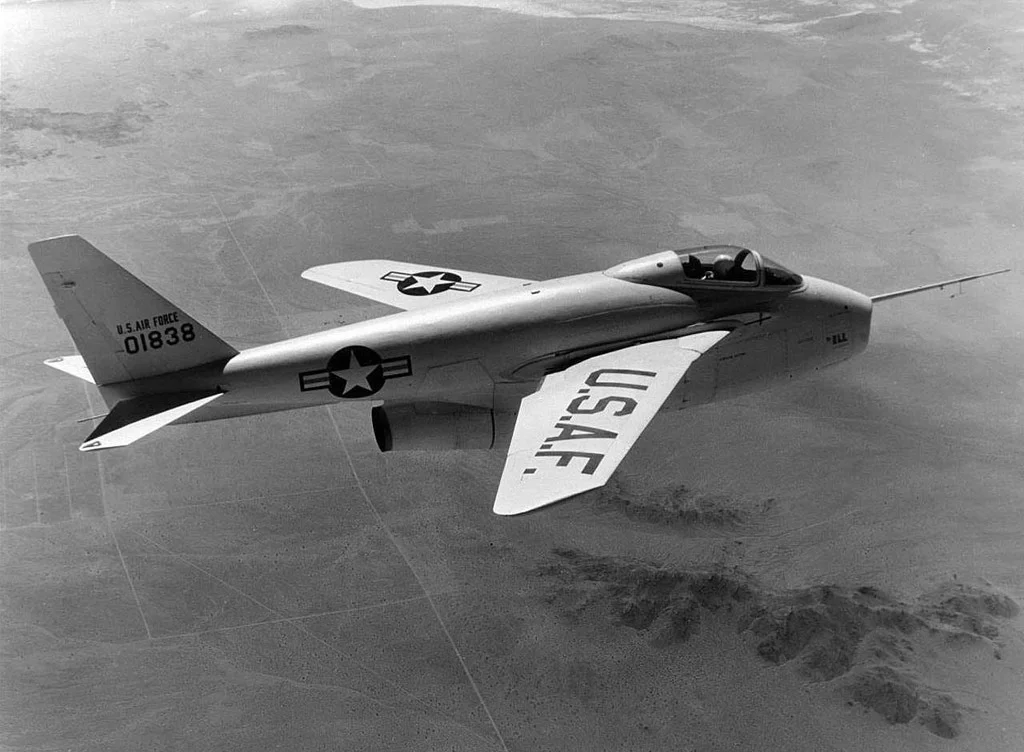The Boeing B-50 Superfortress embarked on its inaugural flight on June 25, 1947, and was officially commissioned into service the subsequent year.
This was an interesting period as its predecessor, the B-29, was still actively in use. The striking similarity between these two “Superfortresses” is not coincidental. This is detailed in a previously archived fact sheet from the National Museum of the United States Air Force.
“The Boeing B-50A Superfortress was the result of a program started in mid-1943 when Pratt & Whitney offered to adapt a B-29 for its more powerful R-4360 radial engines…Although the end of WWII signaled the end of most production contracts, the Army still needed a long-range bomber capable of carrying atomic weapons…Boeing engineers redesigned the basic B-29 airframe for the Pratt & Whitney engines using XB-44 specifications. They also designed a stronger wing and a taller vertical stabilizer for a production aircraft initially designated B-29D. An order for 200 aircraft placed just before WWII ended was in serious jeopardy of being canceled outright; however, the Army redesignated this design B-50A in December 1945. The designation change was partly due to the extensive design changes incorporated into the B-29D and partly to make the aircraft appear as a completely new design to gain funding for production.”
Contents
Background
First of all we have to look at its direct lineage, the B-29. The B-29 Superfortress stands as a profoundly significant and contentious aircraft in human history.
Bearing the contentious distinction of being the most lethal bomber in history and the sole aircraft to deploy a nuclear weapon in combat, its narrative encompasses groundbreaking technological advancements, unprecedented levels of destruction, and pivotal decisions that shaped the trajectory of the 20th century.

It also has to be remembered that the creation of the B-29 bomber emerged as the costliest undertaking of the entire war, amounting to $3 billion, which is comparable to $49 billion in today’s currency. This expense surpassed even that of the Manhattan Project by $1 billion.
Read More: Convair YB-60 the B-52s Competition
The American Boeing B-29 Superfortress, a four-engined, propeller-driven heavy bomber designed by Boeing, saw extensive use by the United States in World War II and the Korean War.
Hiroshima and Nagasaki
Taking its name from its forerunner, the B-17 Flying Fortress, the Superfortress excelled in high-altitude strategic bombing, low-altitude night incendiary bombing, and naval mine deployment to blockade Japan. B-29s hold the unique distinction of dropping atomic bombs on Hiroshima and Nagasaki, the only aircraft to use nuclear weapons in combat.
As one of the largest aircraft in World War II, the B-29 featured advanced technology, including a pressurized cabin, dual-wheeled tricycle landing gear, and an analog computer-controlled fire-control system. This system allowed a gunner and a fire-control officer to operate four remote machine gun turrets.

The B-29 continued to serve in various roles into the 1950s and retired in the early 1960s after a production run of 3,970 aircraft. Stratovision used a few as flying television transmitters. The Royal Air Force operated the B-29 under the service name Washington from 1950 to 1954, until the jet-powered Canberra took over.
The Foundation of the B-50
In 1944, engineers initiated the development of an improved B-29, aiming to replace the unreliable Wright R-3350 Duplex-Cyclone engines. They sought to install the more powerful Pratt & Whitney R-4360 Wasp Major radial engine, the largest displacement aircraft piston engine in America’s large-scale production.
Read More: Weird Wings, Republic XF-91 Thunderceptor
A B-29A-5-BN (serial number 42-93845) underwent modifications by Pratt & Whitney for the R-4360’s test installation in the B-29. This process involved replacing the 2,200-horsepower R-3350s with four 3,000-horsepower R-4360-33s. The resulting aircraft, named XB-44 Superfortress, successfully completed its first flight in May 1945.
The proposed B-29D, powered by the Wasp-Major, planned to feature significant changes beyond the engine upgrade demonstrated in the XB-44. It included the use of a new aluminum alloy, 75-S, creating a wing that was both stronger and lighter than the previous 24ST alloy.

The undercarriage also received enhancements to support up to 40,000 pounds (18,000 kg) more weight than the B-29. To accommodate the increased engine power and weight, designers added a larger, foldable vertical fin and rudder for hangar compatibility and enlarged the flaps.
Read More: He-274 High-Altitude German Bomber
The B-50 fleet also experienced its fair share of initial problems, including faulty pressure regulators, engine troubles, and cracks in its aluminum skin, which took years to resolve. Additionally, with the Pentagon continuously introducing new nuclear bomb designs, the B-50 bombers underwent frequent modifications to accommodate these weapons in their bomb bays.
The sole XB-44
The armament of the B-29 included two bomb bays that carried 20,000 pounds (9,100 kg) of bombs and an additional external capacity of 8,000 pounds (3,600 kg). Its defensive armament comprised 13 × 12.7mm (.50 BMG) machine guns or an alternative setup of 12 machine guns and one 20 mm cannon across five turrets.
The sole XB-44, first flying in May 1945, reached speeds 50–60 mph faster than the standard B-29. However, it’s unclear how much of this speed increase resulted from the aircraft’s lower weight due to reduced armament or the higher power of the R-4360-33 engines.

In July 1945, an order for 200 B-29Ds was placed, but the end of World War II in August 1945 led to widespread cancellations of military equipment orders, including over 5,000 B-29s in September 1945. By December, the order for B-29Ds reduced from 200 to 60, and the aircraft’s designation changed to B-50.
Read More: Frank Whittle the King of the Jet Engine
Officially, the B-50’s new designation reflected its significant revisions, but according to Boeing expert Peter M. Bowers, this was a military tactic to secure funding. He argued that labeling it as B-29D would make it seem like just another version of a model being largely canceled and stored, rather than a substantially new aircraft.
B-50 and the Soviet Union
The first production B-50A, which was effectively a prototype with its engines and new tail already tested, completed its maiden flight on June 25, 1947, followed by 78 more B-50As. The last airframe from the initial order underwent modification to become the YB-50C prototype, designed to use R-4360-43 turbo-compound engines.

This version planned a longer fuselage to merge the two small bomb bays of the B-29 and B-50A into a single large bay, better suited for large nuclear weapons. It also featured longer wings, necessitating additional outrigger wheels for ground stability.
Read More: Weird Wings, Republic XF-91 Thunderceptor
In 1948, orders for 43 B-54s, the intended production version of the YB-50C, were placed. However, Curtis LeMay, commander of Strategic Air Command (SAC), viewed the program as inferior to the Convair B-36 Peacemaker.
Boeing B-47 and B-52 were ready
He criticized its limited potential for improvements and the high cost of redeveloping airbases to accommodate its undercarriage. Consequently, the B-54 program was canceled in April 1949, halting work on the YB-50C before completion.
Although the B-54 was canceled, production of simpler models continued as a temporary solution until jet bombers like the Boeing B-47 and B-52 were ready. Forty-five B-50Bs were built, equipped with lightweight fuel tanks and capable of operating at higher weights. They were followed by 222 B-50Ds, recognizable by their one-piece plastic nose dome and able to carry underwing fuel tanks.

To extend the Superfortress’s range to reach the Soviet Union, B-50s received modifications for in-flight refueling. Most, but not all, B-50As adopted the early “looped hose” refueling system, developed by Flight Refuelling Limited, a British company.
Read More: Wasserfall the Surface-to-Air Missile
This system involved the receiving aircraft using a grapple to catch a line from the tanker aircraft, typically a Boeing KB-29, and then pulling over the fuel line to start fuel transfer. Although effective, this method was cumbersome. Boeing then developed the more efficient Flying Boom method for refueling SAC’s bombers, outfitting most B-50Ds with receptacles for this system.
B-50 Updates
Modifications to the B-50, compared to the earlier B-29 model, enhanced its top speed to just below 400 miles per hour (640 km/h). The changes involved:
- Upgraded to more powerful engines.
- Implementation of redesigned engine nacelles and mounts.
- Expansion of vertical tail and rudder to ensure reliable yaw control in engine-out scenarios.
- Strengthened landing gear, accommodating an increased takeoff weight from 133,500 pounds (60,600 kg) to 173,000 pounds (78,000 kg).
- Enhanced wing structure, necessitated by the larger engine mass, bigger propeller gyroscopic forces, increased fuel load, and revised landing gear stress.
- Modifications in the routing of engine gases, including adjustments to cooling, intake, exhaust, intercooler ducts, and oil lines.
- Addition of underwing fuel tanks to boost fuel capacity.
- Upgrades to remote turret fire-control equipment.
- Refinements to flight control systems, addressing the handling challenges posed by the B-29, intensified by the B-50’s added weight.
- Replacement of the B-29’s castering nose wheel with nose wheel steering for improved maneuverability.
Going Operational
Notably, during the Korean War, the B-50 was not utilized for bombing missions, as the Air Force preferred using the B-29 for such operations. Instead, the RB-50 variant of the aircraft served in a photographic reconnaissance role during the conflict.
Between 1947 and 1953, Boeing manufactured 370 units of the various B-50 models and variants, with the tanker and weather reconnaissance versions serving until 1965.

In June 1948, the Strategic Air Command’s 43d Bombardment Wing at Davis–Monthan Air Force Base, Arizona, received the first B-50As. The 2d Bombardment Wing at Chatham Air Force Base, Georgia, also acquired B-50As.
Read More: Supermarine P.B.31E Nighthawk Zeppelin Hunter
In 1949, B-50Ds were delivered to the 93d Bombardment Wing at Castle Air Force Base, California, and the 509th Bombardment Wing at Walker Air Force Base, New Mexico. The final SAC wing to get B-50Ds was the 97th Bombardment Wing at Biggs Air Force Base, Texas, in December 1950. These wings had the critical mission of delivering atomic bombs to enemy targets.
301st Bombardment Wing
From 1951 to 1953, B-50s from the 4925th Special Weapons Group at Kirkland Air Force Base in Albuquerque, New Mexico, conducted atomic bomb drops in a series of tests at Frenchman Flat, Nevada.
In early 1951, the 301st Bombardment Wing at MacDill Air Force Base, Florida, received some B-50As from Davis–Monthan for non-operational training while awaiting B-47A Stratojets in June 1951. The Air Force built the B-50 as a temporary strategic bomber, planning to replace it with the B-47 Stratojet. However, delays in the Stratojet’s development kept the B-50 in service well into the 1950s.

In 1949, the Air Force developed the RB-50, a strategic reconnaissance version of the B-50B, to replace the aging RB-29s used by SAC for intelligence operations against the Soviet Union. They produced three different configurations, later named RB-50E, RB-50F, and RB-50G. The RB-50E specialized in photographic reconnaissance and observation missions.
Read More: Horton: FMA I.Ae. 37 a Prototype Jet Fighter
The RB-50F, similar to the RB-50E, included the SHORAN radar navigation system for mapping, charting, and geodetic surveys. The RB-50G’s role was electronic reconnaissance. The 55th Strategic Reconnaissance Wing mainly operated these aircraft. During the Korean War, the 91st Strategic Reconnaissance Wing also used RB-50Es, replacing the RB-29s for photographic reconnaissance over North Korea.
Soviet Union
During the early Cold War years, the vast northern borders of the Soviet Union had many open areas with scant defensive radar coverage and limited detection capabilities.
The 55th SRW’s RB-50 aircraft frequently flew sorties along these borders and, when needed, penetrated deeper into Soviet territory. Initially, Soviet forces offered little resistance due to sparse radar coverage, and their World War II-era fighters couldn’t intercept the high-flying RB-50s.
However, with the introduction of the MiG-15 interceptor in the early 1950s, these missions became extremely dangerous. Several RB-50s were shot down by Soviet air defenses, and intelligence personnel scrutinized the wreckage.
By 1954, RB-50 missions over Soviet airspace ceased, giving way to the RB-47 Stratojet intelligence aircraft, which could fly at higher altitudes and near-supersonic speeds.
However, incorporate 13 computer-guided M2 Browning .50 caliber defensive machine guns, and even North Korean MiG-15 pilots hesitated to attack the B-50’s heavily defended rear.
Read More: Fokker D.XXIII – A Promising Twin-Engine Fighter Prototype
Furthermore, the MiG-15, capable of reaching speeds near 680 miles per hour and exhibiting rapid climb rates, showed that the B-50’s increased speed and altitude offered little advantage against advancing jet technology. As a result, in 1949, an experimental re-engined model initially named the YB-50C, equipped with 4,500-horsepower engines, was canceled.
Boeing B-47 Stratojet
Starting in 1953, manufacturers produced the B-47 Stratojet in large numbers, and it eventually replaced the B-50Ds in SAC service by 1955. After retiring from nuclear-bomber duties, many B-50 airframes converted into aerial refueling tankers.
With more powerful engines than the KB-29s used by Tactical Air Command (TAC), the B-50 better suited refueling tactical jet fighters like the F-100 Super Sabre.
As tankers, KB-50s featured heavily reinforced outer wing panels, equipment for air-refueling three fighter-type aircraft simultaneously using the probe and drogue method, and removed defensive armament.
The first KB-50 took flight in December 1955 and the Air Force accepted it in January 1956. These tankers gradually joined TAC’s operational inventory, replacing KB-29s.
Read More: Zveno Project an Incredible Aviation Concept
By the end of 1957, all TAC aerial refueling squadrons had their full quota of KB-50s. TAC, along with USAFE and PACAF overseas, used KB-50s and later KB-50Js with two General Electric J47 jet engines as aerial tankers. Some served in Thailand, flying refueling missions over Indochina in the Vietnam War’s early years until retirement in March 1965 due to metal fatigue and corrosion.
Besides tanker conversion, the Air Weather Service, by 1955, had depleted its WB-29s used for hurricane hunting and other weather missions. Thirty-six former SAC B-50Ds, stripped of armament, equipped for long-range weather reconnaissance.
The WB-50 outperformed the WB-29 in height, speed, and duration. However, from 1956 to 1960, it had 13 major operational accidents, with six resulting in total crew loss and 66 crew fatalities. After grounding the weather reconnaissance fleet in May 1960 due to fuel leaks, the Air Force planned in 1962 to modify B-47 Stratojets, phased out of SAC, for this role.
The WB-50 played a key role during the Cuban Missile Crisis, monitoring weather around Cuba for photo-reconnaissance flights. Finally, in 1965, the WB-50 retired due to metal fatigue and corrosion.
Lucky Lady II
The United States Air Force’s B-50 Superfortress, known as Lucky Lady II, achieved the historic feat of circling the world nonstop in 1949, with the assistance of in-flight refueling. The journey lasted an impressive 94 hours and 1 minute. Unfortunately, the plane later suffered an accident, and today, only its fuselage is preserved.

Lucky Lady II belonged to the 43rd Bombardment Group and was armed with 12 .50-caliber (12.7mm) machine guns. To undertake the circumnavigation mission, an additional fuel tank was installed in the bomb bay to extend its range. The mission required a double crew, including three pilots, under the command of Capt. James Gallagher. The crews worked in shifts lasting four to six hours.
With a total crew of 14, the aircraft commenced its round-the-world journey at 12:21 p.m. on February 26, 1949, taking off from Carswell Air Force Base near Fort Worth, Texas, and heading east towards the Atlantic Ocean.
Read More The DINFIA IA 38: A Forgotten Chapter in Aviation History
Covering a distance of 23,452 miles (37,742 kilometers), the aircraft passed by the control tower back at Carswell on March 2 at 10:22 a.m., signifying the completion of the circumnavigation. It safely landed at 10:31 a.m., two minutes ahead of the estimated time of arrival calculated at takeoff.
During the journey, the aircraft received four in-flight refuelings from KB-29M Superfortresses. These refuelings occurred near Lajes Air Base in the Azores, Dhahran Airfield in Saudi Arabia, Clark Air Base in the Philippines, and Hickam Air Force Base in Hawaii, using the soon-to-be-obsolete grappled-line looped-hose technique.
Tragically, after the refueling near Luzon, Philippines, the refueling tanker encountered adverse weather conditions and crashed on March 1, 1949, resulting in the loss of all nine crew members. The accident report was modified to state that the tanker was on a routine training mission to avoid casting a negative light on Lucky Lady II’s successful circumnavigation.
Throughout its journey, the aircraft operated at altitudes ranging from 10,000 to 20,000 feet (3,000 to 6,100 meters) and achieved an average ground speed of 249 mph (401 km/h; 216 knots).
Intercontinental Bombers
General Curtis LeMay, who served as the commanding general of Strategic Air Command, personally welcomed Lucky Lady II upon its arrival. He was joined by distinguished individuals, including Secretary of the Air Force W. Stuart Symington, Air Force Chief of Staff General Hoyt S. Vandenberg, and Major General Roger M. Ramey, who commanded the Eighth Air Force.
Read More Convair R3Y Tradewind, the Flying Boat That Never Was
LeMay emphasized that the mission demonstrated the Air Force’s capability to deploy bombers from the United States to any location worldwide that required the use of atomic bombs. He also highlighted the potential for mid-air refueling to benefit fighter aircraft. Symington pointed out that aerial refueling had the potential to transform medium bombers into intercontinental bombers.
In recognition of their remarkable achievement, each member of the aircraft’s crew received the Distinguished Flying Cross. Additionally, they were honored by the National Aeronautic Association with the prestigious Mackay Trophy, which acknowledges the most outstanding flight of the year. The Air Force Association also awarded them the Air Age Trophy for their exceptional contributions.
Lucky Lady II Crashed
On August 13, 1950, at 11:25 a.m., B-50A 46-010, commanded by Captain Warren E. Griffin, was conducting a maintenance test flight and returning to its base, Davis-Monthan AFB in Tucson, Arizona. During the flight, all four engines unexpectedly failed.

Captain Griffin skillfully executed an emergency landing in the desert approximately two miles southeast of the runway. Despite having the landing gear deployed, the bomber suffered significant damage, including bent propellers, a dented belly, and a severed tail section.
Read More The V-2 Rocket What Happened to This Superweapon?
Remarkably, the 11-man crew emerged from the incident unharmed, except for 1st Lieutenant Theodore Hastings, the bombardier, who sustained minor scratches from cactus fragments that entered the cockpit through the damaged Plexiglas nose.
Regrettably, the Superfortress sustained irreparable damage and was subsequently removed from the Air Force’s inventory, officially considered “written off.” The unrestored fuselage of Lucky Lady II is now on display at the Planes of Fame Air Museum in Chino, California.








